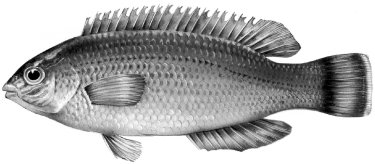
|
Relevant synonyms
Misidentification
Meristic formula
|
|
| drawing : Tuvia Kurz |
|
SHORT
DESCRIPTION
color :
body greenish-brown, often with blueish flecks on the back and fins. Lighter on the belly. Red and blue stripes below the eye. Two dark vertical bars, one at the base of the caudal fin and the other on the caudal fin itself. size : common 10-14 cm (max. 15 cm). |
DISTINGUISHING CHARACTERISTICS
BIOLOGY / ECOLOGY
habitat : neritic, usually associated with rocky and sea grass meadows, to depths of ca. 40 m. |
|
1st
MEDITERRANEAN RECORD
|

|
|
DISTRIBUTION
|
ESTABLISHMENT SUCCESS
speculated reasons for success :
|
|
|
MODE OF
INTRODUCTION |
IMPORTANCE TO
HUMANS |
|
KEY
REFERENCES
|